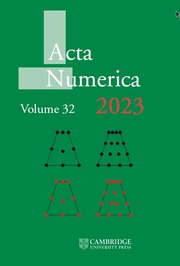Article contents
The discontinuous Petrov–Galerkin method
Published online by Cambridge University Press: 01 July 2025
Abstract
The discontinuous Petrov–Galerkin (DPG) method is a Petrov–Galerkin finite element method with test functions designed for obtaining stability. These test functions are computable locally, element by element, and are motivated by optimal test functions which attain the supremum in an inf-sup condition. A profound consequence of the use of nearly optimal test functions is that the DPG method can inherit the stability of the (undiscretized) variational formulation, be it coercive or not. This paper combines a presentation of the fundamentals of the DPG ideas with a review of the ongoing research on theory and applications of the DPG methodology. The scope of the presented theory is restricted to linear problems on Hilbert spaces, but pointers to extensions are provided. Multiple viewpoints to the basic theory are provided. They show that the DPG method is equivalent to a method which minimizes a residual in a dual norm, as well as to a mixed method where one solution component is an approximate error representation function. Being a residual minimization method, the DPG method yields Hermitian positive definite stiffness matrix systems even for non-self-adjoint boundary value problems. Having a built-in error representation, the method has the out-of-the-box feature that it can immediately be used in automatic adaptive algorithms. Contrary to standard Galerkin methods, which are uninformed about test and trial norms, the DPG method must be equipped with a concrete test norm which enters the computations. Of particular interest are variational formulations in which one can tailor the norm to obtain robust stability. Key techniques to rigorously prove convergence of DPG schemes, including construction of Fortin operators, which in the DPG case can be done element by element, are discussed in detail. Pointers to open frontiers are presented.
Information
- Type
- Research Article
- Information
- Creative Commons
- This is an Open Access article, distributed under the terms of the Creative Commons Attribution licence (http://creativecommons.org/licenses/by/4.0/), which permits unrestricted re-use, distribution, and reproduction in any medium, provided the original work is properly cited.
- Copyright
- © The Author(s), 2025. Published by Cambridge University Press
References
- 2
- Cited by

